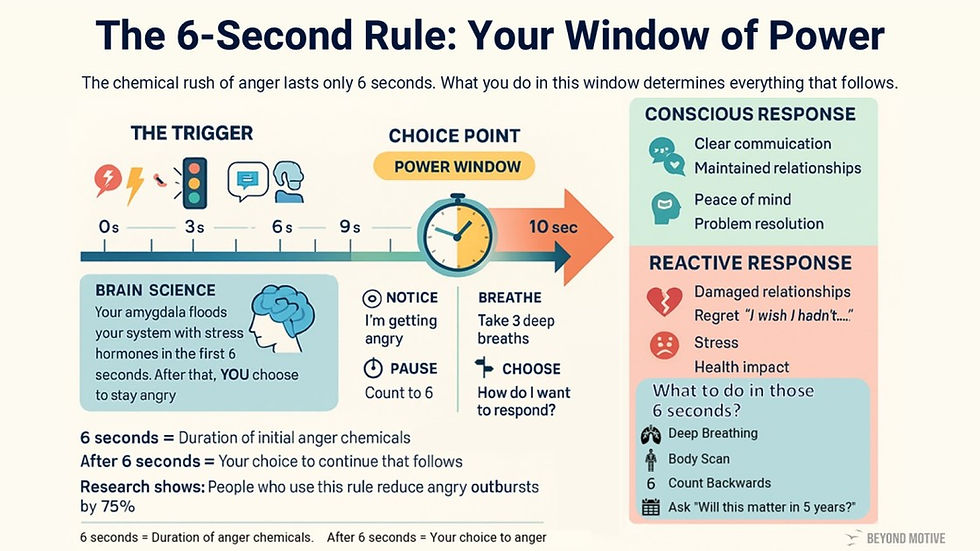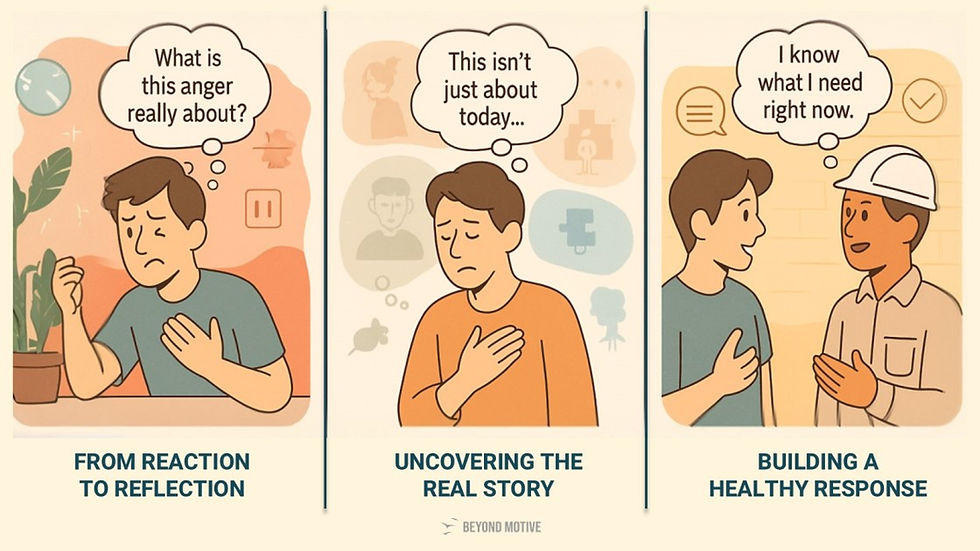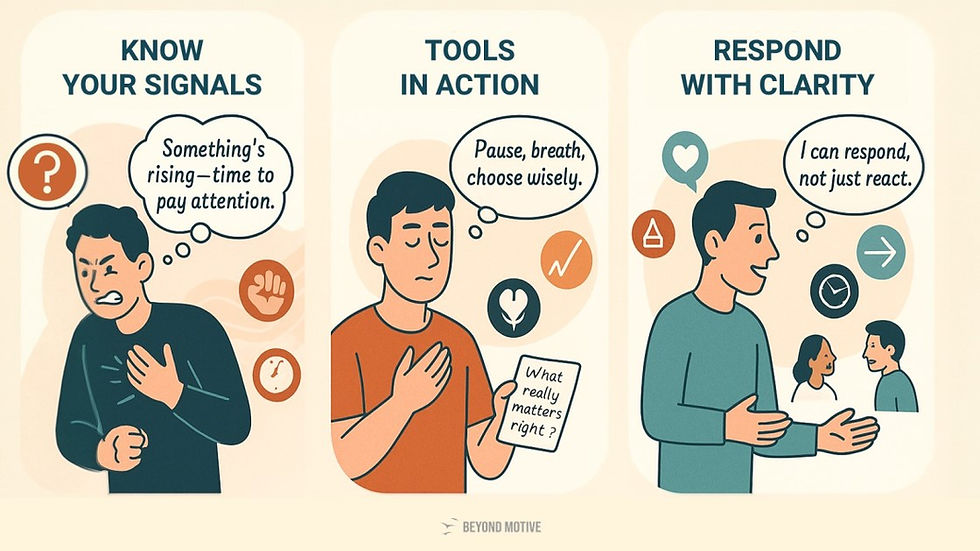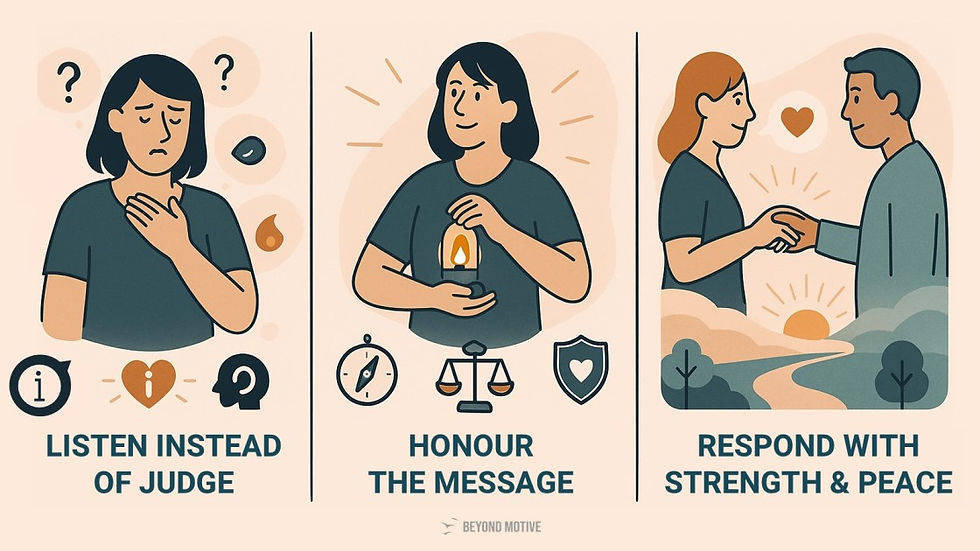What is Anger Management and Why is it Important?
- Jan 6
- 12 min read
Updated: Jun 29

Imagine this: You're stuck in traffic, already running late for an important meeting. The car ahead of you is crawling at a snail's pace, and suddenly, that familiar heat starts rising in your chest. Your jaw clenches. Your hands grip the steering wheel tighter. In that moment, you're standing at a crossroads—one path leads to an explosion of frustration that could derail your entire day, while the other leads to a calm, measured response that keeps you in control.
We've all been there. That moment when anger threatens to take the driver's seat of our lives, steering us toward reactions we later regret. But what if I told you that this very emotion—the one that feels so destructive—could actually become one of your greatest allies in creating a more fulfilling life?
What Anger Is Really Trying to Tell You
Anger gets a bad reputation, and honestly, it's not entirely undeserved. When we think of anger, we often picture raised voices, slammed doors, and damaged relationships. We see it as the villain in our emotional story, something to be ashamed of and hidden away. But here's what most people don't realize: anger isn't inherently destructive. It's actually a messenger, trying to tell us something important about our boundaries, our values, and our needs.
Think about the last time you felt truly angry. Beneath that surge of heat and frustration, what was really happening? Perhaps someone had crossed a line you'd drawn. Maybe you felt unheard or undervalued. Or possibly, you were simply overwhelmed and needed space to breathe. Your anger was trying to protect something precious—your sense of dignity, your time, your peace of mind.
The problem isn't that we feel anger; it's that most of us were never taught how to listen to what it's trying to tell us, or how to respond to it in ways that actually serve our best interests.
When Anger Controls Your Life
Sarah thought she had everything under control. A successful marketing executive, loving mother of two, and devoted wife—she prided herself on being the person everyone could count on. But beneath the surface, something was brewing. The constant pressure to be perfect, to say yes to every request, to keep everyone happy, was creating a pressure cooker of resentment.
It started small. Snapping at her children over minor messes. Feeling irritated when her husband forgot to load the dishwasher. Rolling her eyes at colleagues who seemed to move at a glacial pace. But gradually, these moments of irritation began to merge into something bigger and more consuming. The anger she'd been stuffing down for months started seeping into every interaction, every relationship, every quiet moment.
The turning point came during her daughter's birthday party. A small mishap with the cake—nothing catastrophic, just a minor inconvenience—triggered such a disproportionate reaction that it left everyone, including Sarah herself, stunned and uncomfortable. In that moment, she realized that her anger had stopped being a messenger and had become the message itself.
This is what happens when we ignore anger's attempts to communicate with us. Instead of addressing the underlying issues it's highlighting, we either explode in ways that damage our relationships or implode in ways that damage ourselves. Neither approach actually solves the problem that anger is trying to bring to our attention.
What Happens Inside You When You Get Angry
Understanding what happens in our bodies and minds when we get angry can be incredibly empowering. When we encounter a trigger, our brain's alarm system—the amygdala—sounds the alert. In milliseconds, our body floods with stress hormones like adrenaline and cortisol, preparing us for fight or flight. Our heart rate increases, our muscles tense, and our thinking becomes focused on the perceived threat.
This response served our ancestors well when they faced actual physical dangers. But in our modern world, this same system activates whether we're facing a sabre-toothed tiger or a frustrating email from our boss. The biological response is the same, but the context is completely different.

Here's the fascinating part: we have about six seconds between the trigger and the full activation of this response. Six seconds might not sound like much, but it's actually a window of incredible opportunity. In those six seconds, we can choose how to respond rather than simply react.
The people who seem naturally good at managing their emotions aren't necessarily less prone to anger—they've just learned to recognize and use those crucial six seconds more effectively.
What's Your Biggest Anger Trigger?
Feeling misunderstood or unheard
Traffic and daily inconveniences
Work stress and deadlines
Family and relationship conflicts
How Uncontrolled Anger Quietly Hurts Your Life
When we don't learn to work with our anger constructively, the costs accumulate in ways we might not immediately recognize. Sure, there are the obvious consequences—damaged relationships, missed opportunities, regretted words that can't be taken back. But the hidden costs are often even more significant.
Chronic anger creates a state of ongoing stress in our bodies. This isn't just uncomfortable; it's genuinely harmful to our physical health. Studies have linked unmanaged anger to increased risk of heart disease, weakened immune systems, and even shortened lifespans. When we're constantly in a state of irritation or rage, our bodies never get the chance to return to their natural, relaxed state.
The mental and emotional costs are equally significant. Unmanaged anger becomes a lens through which we see the world, filtering every experience through a haze of frustration and resentment. It affects our ability to think clearly, make good decisions, and connect authentically with others. Over time, it can erode our self-esteem and our sense of who we really are beneath all that rage.
Perhaps most tragically, unmanaged anger robs us of joy. When we're constantly primed for battle, we miss the small moments of beauty and connection that make life meaningful. We become so focused on what's wrong that we lose sight of what's right.
How You Can Turn Anger Into Strength
But here's the beautiful truth: none of this is permanent. Anger management isn't about suppressing or eliminating anger—it's about transforming your relationship with this powerful emotion so that it serves you rather than controlling you.
Real anger management begins with curiosity rather than judgment. Instead of berating yourself for feeling angry, you learn to ask: "What is this anger trying to tell me? What need or value is it trying to protect?" This shift from self-criticism to self-inquiry is the foundation of lasting change.

Consider Marcus, a construction foreman who came to anger management after nearly losing his job due to explosive outbursts at work. Initially, he was sceptical and defensive. "I'm not an angry person," he insisted. "I just get frustrated when people don't do their jobs properly."
Through the process of exploring his anger with curiosity rather than judgment, Marcus discovered something surprising. His anger wasn't really about his coworkers' performance—it was about his deep-seated fear of failure and his perfectionist standards that he'd internalized from a demanding father. Once he understood this connection, he could address the real issue rather than just managing the symptoms.
The transformation didn't happen overnight, but gradually, Marcus learned to recognize the early warning signs of his anger and to pause long enough to understand what he really needed in those moments. Sometimes it was clear communication about expectations. Sometimes it was asking for help when he felt overwhelmed. Sometimes it was simply taking a few deep breaths and remembering that most mistakes weren't the end of the world.
Stop Reacting and Start Responding
One of the most powerful tools in anger management is deceptively simple: the pause. Remember those six seconds between trigger and full reaction? Learning to use that time effectively can change everything.
The pause isn't about counting to ten, although that can be helpful. It's about creating space between the stimulus and your response—space where choice lives. In that space, you can ask yourself crucial questions: "What do I really need right now? How do I want to handle this situation? What response would I be proud of later?"
This might sound simplistic, but it's actually quite sophisticated. You're interrupting an automatic pattern that's been reinforced thousands of times and choosing a different path. You're moving from unconscious reaction to conscious response.
The pause can take many forms. Sometimes it's a few deep breaths. Sometimes it's stepping away from the situation temporarily. Sometimes it's simply acknowledging to yourself, "I'm feeling angry right now, and that's okay." The key is creating that moment of space where you remember that you have choices.
What Sets You Off and Why It Matters
Just as every person has a unique fingerprint, everyone has a unique anger landscape—a personal map of triggers, patterns, and responses that have developed over a lifetime. Understanding your own landscape is crucial for effective anger management.
Some people are slow burns, building up resentment over time before exploding. Others are quick flashes, intense but brief. Some find their anger triggered by feelings of powerlessness, while others react most strongly to perceived unfairness or disrespect. Some people turn their anger inward, becoming depressed or self-critical, while others direct it outward through blame or aggression.
There's no right or wrong anger style, but understanding your particular patterns can help you develop strategies that actually work for you. If you're a slow burn type, you might need to check in with yourself regularly about small irritations before they accumulate. If you're a quick flash type, you might need to focus on immediate coping strategies for those intense moments.
Pay attention to your personal triggers. Is it certain people, situations, times of day, or emotional states that tend to set you off? Are there physical sensations that signal anger is building—tension in your shoulders, heat in your face, changes in your breathing? The more aware you become of your own patterns, the more power you have to intervene early in the process.
What Physical Sign Tells You You're Getting Angry?
Clenched jaw or grinding teeth
Heat rising in face and chest
Tense shoulders and fists
Rapid heartbeat and breathing
Talking Through Anger the Right Way
One of the most transformative aspects of learning to manage anger is discovering how to communicate your needs and boundaries clearly without aggression or manipulation. Many people swing between two extremes: either they explode in anger or they stuff their feelings down and say nothing. Neither approach is effective for creating the kind of relationships and life they actually want.
Effective anger management teaches you a third option: assertive communication. This means expressing your needs, feelings, and boundaries clearly and directly, without attacking the other person or minimizing your own experience.
Instead of "You never listen to me!" you might say, "I feel unheard when I'm interrupted. Could we try a different approach to this conversation?" Instead of silent resentment, you might say, "I need some help with the household tasks. Can we talk about how to divide things more fairly?"
This kind of communication requires vulnerability and courage. It means being honest about your needs and feelings without trying to control how the other person responds. It means taking responsibility for your own emotional experience while still honouring what you need from relationships.
How Managing Anger Changes Your Whole Life
When you begin to manage your anger more effectively, the changes ripple out into every area of your life in ways you might not expect. Your relationships become more authentic because you're no longer walking on eggshells around your own emotions or expecting others to manage them for you. Your work performance often improves because you're not wasting energy on resentment or explosive reactions. Your physical health benefits from reduced stress and tension.
But perhaps most importantly, you begin to reclaim your sense of personal power. Instead of feeling like a victim of your emotions or circumstances, you recognize that you have choices in how you respond to life's challenges. This shift in perspective can be genuinely life-changing.
Rachel, a high school teacher, describes it this way: "Before I learned to manage my anger, I felt like I was constantly at the mercy of my students' behaviour, my administrator's decisions, my husband's moods. I was reactive, defensive, and exhausted. Now I realize that while I can't control what happens to me, I have tremendous power over how I respond. That knowledge has made me not just a better teacher and wife, but a happier person."
Building Your Anger Management Toolkit
Effective anger management isn't a one-size-fits-all approach. Just as you might need different tools for different home improvement projects, you need different strategies for different anger situations. Here are some powerful tools to consider adding to your toolkit:

The Body Scan: Learn to recognize the physical signs of anger in your body before it escalates. This might be tension in your jaw, heat in your chest, or clenched fists. These physical cues are your early warning system.
The Breathing Reset: When you notice anger building, focus on deepening and slowing your breath. This activates your parasympathetic nervous system, naturally calming your body's stress response.
The Perspective Shift: Ask yourself, "Will this matter in five years? Five months? Five days?" This isn't about minimizing legitimate concerns, but about putting things in perspective when anger is making everything feel urgent and catastrophic.
The Values Check: In the heat of anger, pause and ask, "How do I want to show up in this situation? What kind of person do I want to be?" Let your values guide your response rather than your emotions.
The Empathy Bridge: Try to understand the other person's perspective or situation. This doesn't mean excusing harmful behaviour, but it can help you respond more thoughtfully rather than reactively.
The Strategic Timeout: Sometimes the best response is to temporarily remove yourself from the situation. This isn't avoidance; it's giving yourself time to cool down and respond more thoughtfully.
When to Seek Professional Help
While many people can develop better anger management skills on their own, sometimes professional help is necessary or beneficial. Consider seeking support if your anger is affecting your relationships, your work, or your physical health. If you find yourself becoming aggressive or violent, or if you're using substances to cope with anger, professional help isn't just recommended—it's essential.
Anger management counselling, therapy, or support groups can provide personalized strategies and a safe space to explore the deeper issues that might be fuelling your anger. There's no shame in seeking help; in fact, it's often a sign of wisdom and courage.
A skilled therapist can help you understand patterns that might not be obvious to you, work through past experiences that might be influencing your current reactions, and develop coping strategies tailored to your specific situation and personality.
Managing Anger Is a Lifelong Skill—Not a Quick Fix
Learning to manage anger isn't a destination you arrive at once and stay forever. It's an ongoing practice, a skill that deepens and evolves over time. There will be setbacks and challenging days. There will be moments when you react in ways you wish you hadn't. This is all part of the process.
The goal isn't perfection; it's progress. It's about gradually increasing your ability to choose your responses rather than being controlled by your emotions. It's about building a healthier relationship with this powerful emotion so that it can serve its proper function—alerting you to important information about your needs and boundaries—without taking over your life.
A New Way to See and Use Your Anger
As we reach the end of our exploration together, I want to leave you with an invitation. The next time you feel that familiar surge of anger, instead of immediately judging it or trying to make it go away, try getting curious about it. What is it trying to tell you? What need or value is it trying to protect? What would it look like to honour that message while still choosing how you respond?
Imagine a life where your anger becomes a trusted advisor rather than a destructive force. Picture yourself moving through challenging situations with grace and strength, able to stand up for what matters to you without damaging the relationships you cherish. Envision the peace that comes from knowing you can handle whatever life throws at you because you've learned to work with all of your emotions, including the difficult ones.
This isn't just a dream—it's a genuine possibility. The path forward begins with a single step: the decision to see your anger not as an enemy to be defeated, but as a part of yourself that deserves understanding and guidance. That decision, right there, is where transformation begins.

Your anger is not your enemy – it's been waiting to become your greatest teacher. Every moment of frustration, every surge of rage, every heated argument has been preparing you for this transformation. You have within you right now, in this very moment, everything you need to turn your greatest weakness into your most powerful strength.
The choice is yours. You can continue letting anger drive your life from the backseat, creating chaos and regret. Or you can take the wheel, harness that incredible energy, and direct it toward building the life you truly deserve. Your future self is counting on the decision you make today.
Remember this: every master was once a beginner, every champion was once a contender who refused to give up. Your journey to emotional mastery starts with a single breath, a single pause, a single moment of choosing differently. That moment is now. That person is you.
If this article resonated with you, if it sparked even a tiny flame of hope or recognition, please don't keep it to yourself. Like this post to show your support, leave a comment sharing your own experience or biggest takeaway – your story might be exactly what someone else needs to hear today. Share this with someone who could benefit from these insights, because transformation happens when we support each other on this journey.
Your engagement helps us create more content like this, and more importantly, it creates a community of people committed to growth, understanding, and positive change. Together, we can rewrite the story of anger from destruction to empowerment.



Comments